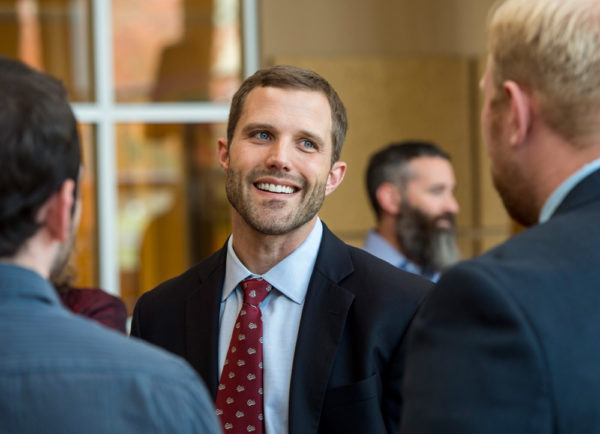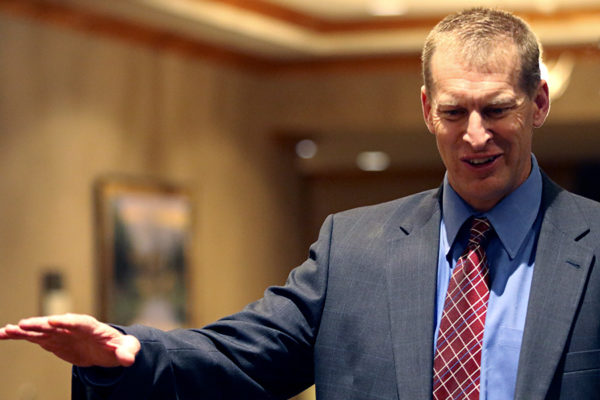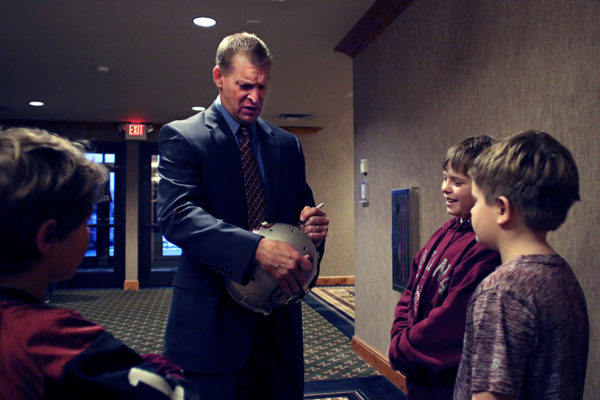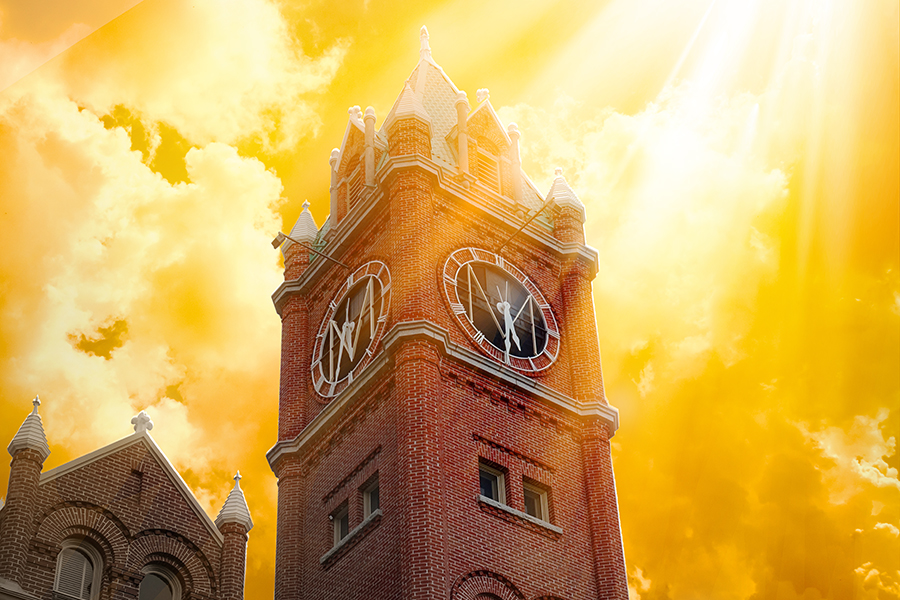An Illinois kid named Doug Betters made his way, serendipitously, to the University of Montana for the first time more than 40 years ago as a highly touted football defensive lineman. Since then, Betters has ridden life’s roller coaster with grace, from the heights of sports stardom, including the 1983 NFL Defensive Player of the Year award, to the depths of a paralyzing ski accident. Through it all, every rise and every fall, every loop and every turn, even the twist that took him to the University of Nevada-Reno for his senior year of college, Betters has been one thing, always: a Griz, through and through.
When his football career ended, he made Whitefish home, and when fall hits the Flathead Valley each year, Betters, like the rest of us, watches the smoke from simmering wildfires settle in around him and throw an ominous blanket over the otherwise-pristine landscape.
Lately, when fall rolls around, Betters also sees his Griz disappearing deeper into the dark clouds circling Washington-Grizzly Stadium. He’s seen, like the rest of us, UM and its football team connected to a highly publicized spate of sexual assaults, physical attacks and bad behavior. He’s seen the damning federal investigations, the no-holds-barred book, the often-criticized leadership and, least importantly but not insignificantly, the losses mount on the gridiron. He’s seen enrollment drop to critical levels, upheaval in the administration and the reputation of his university dragged through the mud.
In the last few months, however, as the winter malaise in the Flathead Valley prepares for the sun’s triumphant return, the University of Montana has been trying to rediscover its glow, too. And if all goes as planned, a young, passionate new president is a bright beacon for the future, and a returning, reinvigorated football coach is the stabilizing leader the school’s flagship sports program has been missing.
Betters, musing from his winter retreat in Florida last week, could not help but draw a parallel.
“It seems like we’ve all kind of been in a funk here the last few falls,” Betters said. “Literally a black cloud over all of us.”
“Maybe the clouds will part and the sun will shine in Missoula.”
Seth Bodnar is, indisputably, a non-traditional pick as the University of Montana’s 18th president. The West Point and University of Oxford grad has never been a college administrator and was hired at 38 years old, having come to Missoula after serving as a senior executive at General Electric.
His term began Jan. 1, and to his credit, Bodnar looks, speaks and carries himself like a man up to this or any challenge. Blue-eyed, with a tight beard and clean smile, Bodnar is a U.S. Army Special Forces veteran who is energetic, charismatic and warm in a way that complements his discipline and drive. He stays on message with poise and precision, and has a quiet confidence that no doubt served him well in his prior work, whether on deployment as a Green Beret or in GE’s boardroom.

Bodnar, too, has so far been willing to face head-on an uncomfortable truth about his new employer: that the University of Montana is still in the midst of a seemingly endless financial crisis driven by an unprecedented drop in enrollment and has an image problem that, if not corrected, could sink the university even further. In late January, the Missoulian reported Bodnar said the school is at a “critical juncture” and needs to make up an approximately $10 million budget gap in the next four years.
“A lot of it had to do with the challenges associated with a drop in enrollment,” Bob Nystuen, the vice-chair of the Montana Board of Regents, said of UM’s current predicament. “(The university has to) rebrand the institution to be attractive to high school graduates and the workforce.”
The University of Montana’s undergraduate enrollment, on the Missoula campus, was 10,891 students in the fall of 2010. Seven years later, that number had plummeted to 7,550. And the number of first-time freshman enrollees during that same span fell more than 30 percent, from 1,893 to 1,292, although first-time freshman enrollment enjoyed a slight uptick from fall 2016 to fall 2017, its first increase since 2010.
As for the school’s brand — a too-corporate term that Bodnar resists — the change is easiest to quantify in comparison to the enrollment at the state’s other flagship college, Montana State University. Over the same stretch, from 2010-17, MSU’s undergraduate enrollment has rocketed from 11,579 to 14,725. MSU’s current president, Waded Cruzado, has steered the university through that period of growth after assuming her post in January 2010.
A tougher-to-quantify reflection of UM’s brand deterioration is something Grady Bennett, the former UM quarterback who teaches and coaches football at Glacier High School, has literally seen with his own eyes and discussed with recently fired UM football coach Bob Stitt when Stitt’s tenure began, in 2015.
“There was a stretch, most of my (teaching) career, where I could not catch a kid wearing a (MSU) Bobcats sweatshirt,” Bennett said. “And now, it’s the opposite. There’s Bobcats stuff everywhere. And if I see a kid wearing a Griz sweatshirt I’m like, ‘Whoa.’ So I told (Stitt), ‘We’ve got to do something.’”
Bodnar, ever the optimist, believes his school is at a distinct advantage when it comes to rebranding because he believes that if the story of the University of Montana and its academic programs gets out, it’s a story that sells itself.
“The good news is we’ve got a great university,” Bodnar said from his office in University Hall last week. “This isn’t trying to put a glossy brochure about a bad place, this is a great university that just needs to be more coordinated, more intentional and spend a little bit more money in terms of making sure people see and hear that.”
The mechanism by which that story is told is still a work in progress — the university’s director of integrated communications left the school at the end of 2017 and Bodnar is assessing how the communications office will be organized moving forward — but the story itself has a handful of easy-to-digest talking points.
“I don’t think everyone understands the excellence of the offerings that we have here,” he said. “The fact that we have the number one wildlife biology program in the country; the fact that our journalism school’s top 10; our creative writing program is nationally recognized.”
Bodnar is also stressing the school’s STEM (science, technology, education and math) offerings, something more commonly perceived as MSU’s strong suit. He has frequently cited a recent list, authored by Clarivate Analytics, of the “Most Influential Scientific Minds” in the world. Only three scientists mentioned are Montanans, and all three, as Bodnar happily points out, work with UM.
“Over the years, liberal-arts type of institutions may not have been in favor,” Nystuen said of UM’s public pivot to the sciences. “A big part of what we’ve been about is looking for ways to create programs and fields of study that are attractive to students coming out of high school — what are the core competencies — and promote them and make (UM) a very attractive place to go to college.”
There is another mouthpiece for the University of Montana who, fairly or not, is more recognizable and more influential than even the new president.
He is the Grizzlies’ football coach.
“You’re talking to one of the biggest proponents of the university, take away the head coaching title,” new Griz coach Bobby Hauck said at a recent booster event in Kalispell. “I love the place … In fact, when I’m recruiting, I can tell kids (Missoula) is the greatest college town in America, and I can make an argument that you can’t beat me in a debate on.”

The hard-charging Hauck is a UM alum, and his children will be the family’s fourth generation to attend the school. A Montana native, Hauck returns to the team he led from 2003-09, a tenure that saw the Griz go 80-17 and reach three national championship games. He is the second-winningest coach in Montana history, and this time around inherits a program that has sagged since his departure. Stitt went 21-14 in three years as the Griz coach and committed the dual sins of missing the playoffs and losing to rival MSU in back-to-back years.
College sports, as everyone from Bodnar to Nystuen to Hauck to Bennett to Athletic Director Kent Haslam will repeat ad nauseam, are supposed to be, first and foremost, about educating student-athletes and creating future leaders. But if that were truly all that mattered, the national coaching carousels in college football and basketball wouldn’t spin nearly as wildly as they do every offseason. Winning matters.
“The football program at the University of Montana is the flagship program,” Hauck said. “It’s the front porch of the university; it’s the most visible thing we have.”
“And so, representing the university well, winning a lot of football games, bringing national notoriety to the place is the best thing we can do,” he continued. “Historically, if you look back, when the football program’s competing on a national stage, enrollment is up and continues to go up. The exposure is great.”
The Griz won or shared 12 consecutive Big Sky Conference football titles from 1998-2009, a streak that ended the final year of Hauck’s first stint as head coach. But they have not won one, officially, since. They have only four Football Championship Series playoff victories in the last eight years, two of which were vacated because of NCAA infractions (the 2011 Griz were stripped of five wins and a share of the Big Sky title). Whether causative or simply correlative, Hauck is onto something: As the football team has stepped back from the national spotlight, enrollment has dipped, too.
“Obviously it’s a highly visible area,” Haslam said of the football team, after first reiterating the athletic department’s commitment to educating students. “So we also play a role by winning. We want to win. If you’re going to be in a business where it’s competitive, let’s be on the winning side of that.”
Few doubt Hauck’s ability to win, but that’s not the concern some have voiced over his hiring.
It’s impossible to talk Griz football without acknowledging the snarling, hulking elephant in the room: the numerous players who were arrested in Hauck’s final years and the sexual assault allegations linked to football players in the seasons following his departure, including Beau Donaldson, a Hauck recruit, who pleaded guilty to sexual intercourse without consent in 2012. The scandals led to the firings of Hauck’s replacement, Robin Pflugrad, and athletic director Jim O’Day in 2012, along with NCAA sanctions and vacated wins.
The last 10 years of UM football have been marred by national media coverage of the scandals — exacerbated by a hostile interaction Hauck had with a student reporter in his final season — and investigations by the U.S. Department of Justice, the Department of Education and the NCAA. Then, in 2015, Jon Krakauer’s book “Missoula: Rape and the Justice System in a College Town” was released, detailing alleged assaults by UM athletes and other students, and the controversial investigations into those assaults by local authorities. It poured salt in a raw wound and did no favors to the university when it came to recruiting new students.
“This is an issue with which this community has a tough history,” Bodnar acknowledged. “I think it’s painful to have seen the struggles here profiled in a book, right?”
Hauck, who has not and will not read Krakauer’s book, bristled at even the mention of the author’s name.
“I’m not going to read some widely discredited author slam my town and my university,” Hauck said. “I wouldn’t give him much credence.”
Bodnar, Hauck and others are also quick to point out that sexual assaults on college campuses are far from exclusive to the University of Montana. Bennett, the Glacier coach and a passionate shaper of character who regularly counsels his athletes and students on sexual assault, talked about his own difficulties at the high school level.
“I work my tail off as hard as I can teaching character and trying to teach young boys to do the right thing,” he said. “And even myself, we’ve had some bad things happen, and we’ve had some kids make awful decisions. And I know that even myself, I’m one potential bad, boneheaded decision by a young man from being (fired).”

“We’re dealing with 18- to 23-year-old kids; they’re not going to do everything right,” Hauck said of managing his athletes’ behavior. “We try to encourage them to do everything right, but if we recruit the right guys that are going to graduate, going to do their very best to get their degree and play a good brand of football, and then when they all go on to be wildly successful, they can have the same affinity for their university and my university, they’ll come back and help with higher education.”
In the wake of the Department of Justice investigation, UM strengthened the way it handles sexual assault allegations on campus, and in 2013, the Missoulian reported that Montana U.S. Attorney Michael Cotter called the university’s revamped policies for responding to assaults the “gold standard” for other schools to emulate. In the lobby of the president’s office, a “Sexual Harassment and Sexual Assault Resource Guide” sits in front of magazines promoting the school. Bodnar also said he will personally be involved with the University Council on Sexual Assault, a group made up of students, staff and faculty that exists to “examine issues regarding campus policies and procedures addressing sexual assault.”
“Now, I want to be very clear that this work’s never done and we’re continually working to get better,” Bodnar added. “This is an issue that every campus across this country is addressing, and this is an issue on which the University of Montana has led, in a lot of ways. But this is an issue that we’re going to continue to improve upon moving forward.”
If the University of Montana is to thrive in the future, Bodnar believes, it starts with thinking about what the future will look like for today’s college students. One of his favorite lines is that students need to be “prepared for their sixth or seventh job” out of college, paraphrasing Harvard University President Drew Faust.
“Because the reality is our students today are entering a very complex and dynamic job market,” Bodnar said. “The thing about the future is it’s hard to predict, but a lot of studies would tell you that 15 years from now, half the jobs that are going to be available to our students don’t exist today. So how do you prepare students for that?”
As Bodnar works at answering that question, he also has to wrestle with the real, significant cuts that are coming to the school. In November 2015 the university announced it was eliminating more than 200 faculty and staff positions, and the university’s Academic Program and Administrative Services Prioritization project has been identifying what programs can be trimmed or eliminated. Eventually, some of those cuts will need to be implemented as well.
It’s a difficult position for Bodnar and other administrators, who know the simultaneous goals of making a marketing push to increase enrollment and cutting expenditures are often in opposition to each other.
“We’ve had budget challenges, we’ve had places where we cut spending in certain areas, and we’ve seen the results of that, in terms of our ability to talk about the University of Montana in an effective and consistent and comprehensive way,” Bodnar said. “I want to make sure that before we move forward in this that we are intentional, that we’re efficient, that we’re coordinated in how we do so because we don’t have unlimited resources.”
Some of that, too, comes down to both recognizing the mistakes of the past and making sure they are not repeated. When asked whether addressing past missteps and re-hiring a football coach who was part of that past are incongruous, Bodnar is steadfast that Hauck isn’t in Missoula to win football games at all costs, even if it could drive enrollment.

“Success (in our football program) has to come from a focus on the development and success of our students,” he said. “And I believe when we focus on the right things, those wins and losses will follow and good things will result from those wins. But the focus is on the success and the development of leaders of character in our programs.”
It’s a message Bodnar said he has shared personally with his football coach.
“Coach Hauck very much understands those expectations and is aligned with them,” he said.
Hauck, for his part, said the weight of history, both his own and that of the football program, is something he doesn’t feel.
“You asked me if I felt pressure,” he said sharply. “I said no.”
Regardless of the past, how brightly the sun shines in Missoula will have much to do with two men: Hauck and Bodnar.
Now all that’s left is to part the clouds.
